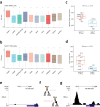Flexible modeling of regulatory networks improves transcription factor activity estimation
- PMID: 38806476
- PMCID: PMC11133322
- DOI: 10.1038/s41540-024-00386-w
Flexible modeling of regulatory networks improves transcription factor activity estimation
Abstract
Transcriptional regulation plays a crucial role in determining cell fate and disease, yet inferring the key regulators from gene expression data remains a significant challenge. Existing methods for estimating transcription factor (TF) activity often rely on static TF-gene interaction databases and cannot adapt to changes in regulatory mechanisms across different cell types and disease conditions. Here, we present a new algorithm - Transcriptional Inference using Gene Expression and Regulatory data (TIGER) - that overcomes these limitations by flexibly modeling activation and inhibition events, up-weighting essential edges, shrinking irrelevant edges towards zero through a sparse Bayesian prior, and simultaneously estimating both TF activity levels and changes in the underlying regulatory network. When applied to yeast and cancer TF knock-out datasets, TIGER outperforms comparable methods in terms of prediction accuracy. Moreover, our application of TIGER to tissue- and cell-type-specific RNA-seq data demonstrates its ability to uncover differences in regulatory mechanisms. Collectively, our findings highlight the utility of modeling context-specific regulation when inferring transcription factor activities.
© 2024. The Author(s).
Conflict of interest statement
The authors declare no competing interests.
Figures




Similar articles
-
Single-cell multi-omics analysis identifies context-specific gene regulatory gates and mechanisms.Brief Bioinform. 2024 Mar 27;25(3):bbae180. doi: 10.1093/bib/bbae180. Brief Bioinform. 2024. PMID: 38653489 Free PMC article.
-
MICRAT: a novel algorithm for inferring gene regulatory networks using time series gene expression data.BMC Syst Biol. 2018 Dec 14;12(Suppl 7):115. doi: 10.1186/s12918-018-0635-1. BMC Syst Biol. 2018. PMID: 30547796 Free PMC article.
-
Causal Inference Engine: a platform for directional gene set enrichment analysis and inference of active transcriptional regulators.Nucleic Acids Res. 2019 Dec 16;47(22):11563-11573. doi: 10.1093/nar/gkz1046. Nucleic Acids Res. 2019. PMID: 31701125 Free PMC article.
-
Computational and experimental approaches for modeling gene regulatory networks.Curr Pharm Des. 2007;13(14):1415-36. doi: 10.2174/138161207780765945. Curr Pharm Des. 2007. PMID: 17504165 Review.
-
Inference of dynamic networks using time-course data.Brief Bioinform. 2014 Mar;15(2):212-28. doi: 10.1093/bib/bbt028. Epub 2013 May 21. Brief Bioinform. 2014. PMID: 23698724 Review.
Cited by
-
In silico screening system based on a transcription factors regulatory network only using transcriptomic data.PLoS One. 2025 Apr 7;20(4):e0319971. doi: 10.1371/journal.pone.0319971. eCollection 2025. PLoS One. 2025. PMID: 40193394 Free PMC article.
-
Identifying Sex Differences in Lung Adenocarcinoma Using Multi-Omics Integrative Protein Signaling Networks.bioRxiv [Preprint]. 2025 Feb 7:2025.02.03.636354. doi: 10.1101/2025.02.03.636354. bioRxiv. 2025. PMID: 39975108 Free PMC article. Preprint.
-
Selective loss of Y chromosomes in lung adenocarcinoma modulates the tumor immune environment through cancer/testis antigens.bioRxiv [Preprint]. 2024 Sep 22:2024.09.19.613876. doi: 10.1101/2024.09.19.613876. bioRxiv. 2024. PMID: 39345481 Free PMC article. Preprint.
-
Single-cell RNA sequencing technology was employed to construct a risk prediction model for genes associated with pyroptosis and ferroptosis in lung adenocarcinoma.Respir Res. 2025 Jul 18;26(1):249. doi: 10.1186/s12931-025-03323-5. Respir Res. 2025. PMID: 40682067 Free PMC article.
References
MeSH terms
Substances
Grants and funding
LinkOut - more resources
Full Text Sources
Miscellaneous

